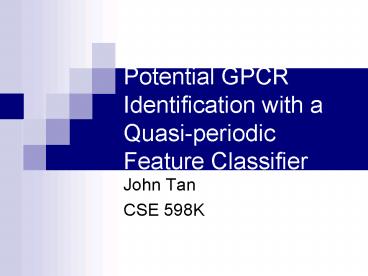Potential GPCR Identification with a Quasiperiodic Feature Classifier - PowerPoint PPT Presentation
1 / 24
Title:
Potential GPCR Identification with a Quasiperiodic Feature Classifier
Description:
Quasi-periodic feature classifier (QFC) relies on ... Average periodicity of the hydrophobicity function. Average periodicity of a polarity function ... – PowerPoint PPT presentation
Number of Views:79
Avg rating:1.0/5.0
Title: Potential GPCR Identification with a Quasiperiodic Feature Classifier
1
Potential GPCR Identification with a
Quasi-periodic Feature Classifier
- John Tan
- CSE 598K
2
Overview
- QFC Algorithm
- G-protein Coupled Receptors
- Applications in Drosophila and Anopheles
- Plasmodium and application of the QFC algorithm
- QFC vs. HMMs
3
QFC Algorithm
- Quasi-periodic feature classifier (QFC) relies on
construction of feature space - Assumption is that this feature space will
support interpolation - A discriminant function is used to optimally
discriminate between the two classes
4
Training the QFC algorithm
- Training set of 750 GPCRs and 1000 non-GPCRs to
derive feature space and discriminant function - 5 parameters to define feature space
- Average periodicity of the hydrophobicity
function - Average periodicity of a polarity function
- Variance in the periodicity of the polarity
function - Variance in the first derivative of the polarity
function - Amino acid usage index
5
Testing the QFC algorithm
6
G-protein Coupled Receptors
- GPCRs are a superfamily of the largest group of
receptors - They are always involved in signaling from the
outside to the inside of the cell where their
response is felt by a G protein - Structurally, they have seven hydrophobic
alpha-helical domains that are usually
interpreted as seven transmembrane regions
7
GPCRs
- Play an indispensable role in signal transduction
serving as neurotransmitter, hormone, olfactory,
and taste receptors - A substantial proportion of worldwide
prescription drug sales today are attributed to
drugs that target GPCRs
8
QFC algorithm applied
- Drosophila melanogaster 2 publications where
potential odorant and taste receptors were
identified - RT-PCR to determine tissue-specific expression
look for expression specific to the corresponding
sensory organ
9
(No Transcript)
10
QFC algorithm applied
- Anopheles gambiae 1 publication identifying
chemosensory receptors. RT-PCR to determine
tissue-specific expression - It is likely that receptors are uniquely
important to the species that they operate in
e.g. receptors for fruit odors in Drosophila and
human odors for Anopheles
11
Plasmodium falciparum
- Parasite that causes malaria
- Huge burden on affected areas annually causes
over 300 million cases and over 1 million deaths - Disease is spread by mosquitoes. They are an
integral part of the disease cycle - Drug resistant Plasmodium and mosquitoes are now
rampant
12
GPCRs in Plasmodium
- 1 putative GPCR has been identified
- Potential GPCRs in Plasmodium are intriguing for
several reasons - Usually only found in higher organisms
- Attractive as potential drug targets
- What function do they serve?
13
QFC applied to Plasmodium
- Two versions of QFC available, neither of which
gave results matching those published by the
original authors
14
Target Validation?
- RT-PCR approaches are not useful parasites are
internal to the red blood cells - GFP-fusion protein to determine localization
- Green fluorescent protein (GFP) fluoresces under
UV light - Clone coding region for a target gene into a
vector containing GFP transfect into Plasmodium
determine localization by fluorescence
15
Target Validation?
- GFP-fusion would be time-consuming
- Focus on top 25 hits tools to predict
transmembrane regions (TMHMM2) and BLAST - Of the top 25 hits 14 are hypothetical, 2 are
pseudogenes, 8 have putative annotation, 1 has
been assigned a function
16
Target Validation
- All but two have predicted transmembrane domains.
- 12 have gt 7 predicted transmembrane domains
- 11 have lt 7 predicted transmembrane domains
- Genes could represent fragments of the final
protein product
17
BLAST
- Many hits were to other hypothetical proteins
- Some interesting hits but matches werent highly
significant - Example results from the top ranked target
PFI0400c hypothetical protein with 6 predicted
transmembrane regions
18
(No Transcript)
19
(No Transcript)
20
Potential GPCRs in Plasmodium
- The one gene already annotated as a putative GPCR
wasnt identified by any of the algorithms - If a GPCR was identified, it would be interesting
to BLAST against the P. falciparum genome to try
to find other similar genes in the same family
21
QFC vs. HMMs
- QFC algorithm has been changed and HMMs have been
changed since original publication - Pfam 4.0 using 4 HMMs as of Nov. 2004, Pfam 16.0
with 6 HMMs representing GPCRs
22
Discussion and Conclusion
- The QFC algorithm performs at a high level but is
suited to different uses from HMMs - HMMs must be constructed and trained from
sequences of known protein families they will be
more specific and less generalized - HMMs are less useful when underlying structure is
preserved but primary sequence is not as conserved
23
Discussion and Conclusion
- One common theme was the sequence divergence of
GPCRs in this respect, the QFC is well-suited to
recognize GPCRs - Target validation can be a problem
- RT-PCR approaches require knowledge that
expression will be temporally/spatially specific
and can be isolated at these points - BLAST results can be very hit-or-miss
24
Discussion and Conclusion
- The construction of a feature space supporting
interpolation could be used to create other
classifiers - Some protein families may not be able to be
parameterized with variables that could be used
to distinguish it from other families - The QFC algorithm is capable of providing
guidance in the right direction































